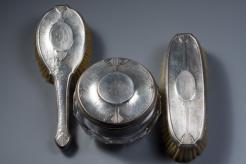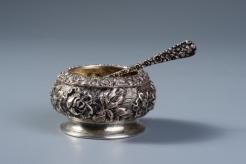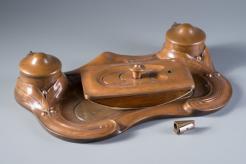




Author: Valda Vilīte, Mag.art.
Metal art collection of the museum “Riga Art Nouveau Centre” (hereinafter - RANC) – the greatest collection of this kind in Latvia – consists of purposefully purchased pieces, as well as gifts representing various epochs and of different quality levels. Artworks were manufactured not only in Latvia, but also in Germany, Poland, England, Finland, Sweden, Russia and the USA. So far only silver and pewter pieces have been studied, whereas pieces of other types of metal have been widely analysed for the first time. Upon viewing household objects as an integral part of the unified style of the building and its interior, an overall view on Riga and its inhabitants in the early 20th century can be captured.
Upon the influence of the Art Nouveau, metalworking companies intensively worked to diversify their products and adjust them to new requirements resulting from industrial reform of the 19th century. In 1838, in Birmingham, England, George Richards Elkington patented gold and silver plating of white metals by applying electroplating method, thus saving precious metals and cheapening the process. In 1842, French manufacturer of fine silver Charles Christofle was the first one outside of England to licence this method. Later it was improved in cooperation with French chemist Graf Henri de Roulz.
In 1833, Robert Wallace, the son of Scottish silversmith who left Scotland for the USA at the end of the 19th century,purchased a dilapidated gristmill and ran a workshop and a shop specialising in manufacturing and selling of silver spoons. In Sheffield, England, he got acquainted with manufacturing of silver-plated white metal objects, he purchased the licence for silvering method from German chemist Ludwig Feuchtwanger thus becoming the pioneer of the new industry in the USA. Meanwhile, intensive experiments for obtaining of cheaper and more durable fusions were taking place. New alloys (Britannia metall, argentan, alfenide, alpaka, orivit) were developed in newly built factories equipped with up-to-date equipment. Besides the mark of the factory, special marks specifying date, place of manufacturing, as well as method and content of the metal were also engraved on ready-made objects.
In 1851, “The Great Exhibition of the Works of Industry of all Nations” was held in London, at Crystal Palace, Hyde Park. The exhibition marked the transition from craft production towards industrial production, elements of almost all previous styles of art were used with regard to shape and decoration. Exhibitions in Paris and London fostered spread of innovations and interest in affordable decorated mass products, artists were attracted by factories, schools were established and sample albums were published on a regular basis. In 1857, Victoria and Albert Museum of Decorative Arts and Design was founded in London, in 1864 the Imperial and Royal Austrian Museum of Art and Industry was established in Vienna, whereas, in 1881 Arts and Crafts Museum opened its doors in Berlin. First exhibitions were strongly criticised with regard to their quality, however it tended to improve in the course of time. Around 1896, overcrowded eclectic decorations were replaced by stylized natural forms and curved lines – basic motif of the Art Nouveau, and according to N. Pevsner, “a long sensitive curve reminiscent of the lily’s stem, an insect’s feeler, the filament of a blossom, or occasionally a slender flame”.
More information will be available in the virtual exhibition, which will be established till April 2016.